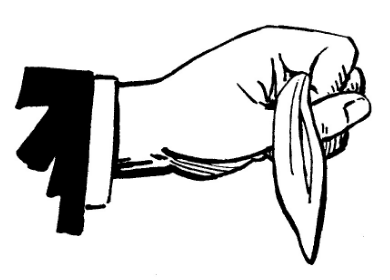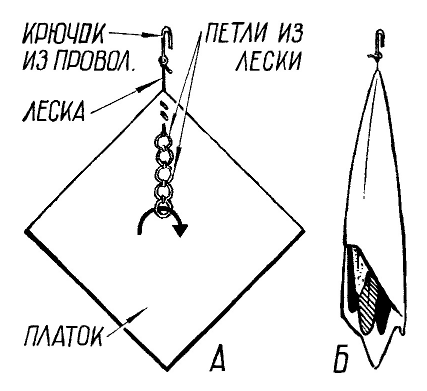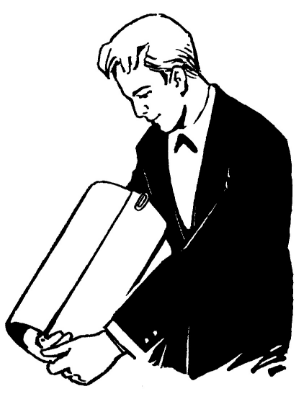
|
|
EFFECTIVE FOCUSES AND THEIR CLUES The second session with handkerchiefs (several tricks). Focus Secret
Directory / Spectacular tricks and their clues Session description: Having shown that his hands are free, the performer turns sideways towards the audience and pulls up his sleeves to expose his wrists. Then, turning the other side to the audience and bringing the palms of his hands together, he begins to roll a ball (from snow or clay) between them. And indeed: after a few seconds a ball appears in the magician’s hands, which he holds between his thumb and forefinger, showing it to the audience. After this, the leader again takes the ball between his palms, folded into a handful, moves his thumbs, as if unwinding the ball, and from under his thumbs first the tip of the scarf appears (Fig. 74, A), and then the entire scarf. So the ball “turns” into a scarf, which, holding by two adjacent corners, the presenter shows to those present (Fig. 74, B).
Then the illusionist goes to the work table behind the “magic” salt shaker and, returning to his original place, throws a scarf over his left outstretched palm and wrist, sprinkles it with “magic powder” and hides the salt shaker in his jacket pocket. Taking the handkerchief by the middle, he holds it as shown in Fig. 75, A, the scarf falls in the shape of a cone; All four corners of the scarf, brought under the base of the hanging cone, the performer lifts up - thus in his hand he ends up with a kind of knot (Fig. 75, B), which he takes in a handful of his left hand (Fig. 75, C).
Carefully straightening the knot, the artist pulls out a bright handkerchief through the fingers of his left hand; placing it on his shoulder, he takes out the second scarf in the same way and also places it on his shoulder. The third magician takes with his right hand the corner of the scarf from which he has just pulled out two other scarves. With his left hand, the performer takes out a “magic” wand from his inner pocket and, having made several passes over the scarf, takes the wand to the work table. Returning, he stands sideways to the audience, stretching his arms forward (see Fig. 68), collects the scarf between his palms - and the scarf disappears from the magician’s hands. Having shown that his hands are empty and after a pause, the artist proceeds to continue the trick. From the inside pocket of his jacket, he takes out a piece of thick paper 12x12 cm, shows both sides of it and the sheet of paper in the light, hits it hard with the palm of his hand - the sheet without any catch. Holding the paper in his left hand, the illusionist takes the salt shaker with his right hand and, having sprinkled the leaf, hides it in the outer pocket of his jacket, and then rolls up a small tyurichek from the paper, removes the smallest scarf from his shoulder - 15x15 cm, throws it up, catches it, and slowly pushes it inside the tyurichek and, when the handkerchief completely disappears inside, he unfolds the sheet and, turning it in front of the audience on both sides, at the same time, with quick and strong movements, hits the sheet with his hand - the handkerchief has disappeared. The presenter rolls up the tyurik again and slowly takes out the scarf that just disappeared. Then he puts the scarf back into the tyurik - the scarf disappears again, and then appears again. So 4-5 times the scarf disappears before the eyes of the audience, then appears again. Finally, the scarf disappears for the last time; the artist unrolls the paper, takes out a salt shaker, sprinkles it on the sheet of paper, passes it to the audience, and places the salt shaker in plain sight. After giving the audience time to familiarize themselves with the piece of paper handed over to the audience, the artist continues the performance. Having shown his hands to those present (they are empty), the performer removes the last scarf from his shoulder. Having unfolded it, he shows both sides of it, throws it up, catches it, takes the salt shaker and, having sprinkled it on his handkerchief and left hand, hides the salt shaker in the outer pocket of his jacket. Then, slowly, with stops, he pushes the handkerchief inside his left fist until it is completely hidden. The performer holds his left arm outstretched and looks at his left fist, in which the handkerchief is hidden; suddenly the fingers hiding the scarf moved. The audience immediately reacted to this with a slight noise. The artist noticed this and pulled the tip of the handkerchief out of his fist to prove to those present that, in fact, nothing happened (Fig. 76).
However, as soon as he hides the handkerchief in his fist and moves his fingers, the same reaction occurs in the audience. So he has to repeat this joke 3-4 times. Finally, having hidden the handkerchief for the last time, the magician no longer moves his fingers, but takes out a “magic” wand from the left inner pocket of his jacket. Having made several passes, he hides the wand back in the same pocket, and then, using his left fist, he sharply throws the handkerchief up, but alas, the handkerchief is gone, it has disappeared. It is not in the right hand either. The artist bows and goes backstage. The assistant cleans up the stage. After an interval, the illusionist appears on stage again. Usually the public greets magicians with excitement. As if wanting to thank those present for the warm welcome, the artist begins showing a new trick. In response to his clap, the assistant brings out a sheet of white drawing paper and two large paper clips. Having walked along the ramp, the artist shows the sheet on both sides and in the light, invites one of the spectators sitting in the first row to come up to the ramp and personally inspect this sheet. Moving a little further from the ramp and standing next to his assistant, the performer rolls up a cylinder from the sheet, fastening it at the top and bottom with paper clips. Then, from this cylinder, the presenter takes out 8-10 bright multi-colored scarves one by one and places them on a tray held by the assistant. Having removed the paper clips and unfolded the sheet, the artist again shows it to the audience, going to the front of the stage. Returning to his original place, he again rolls and fastens the sheet into a cylinder, from which he again takes out another 8-10 multi-colored scarves. After this, he again unfolds the sheet, shows it to the audience and bows, pausing. Then, taking one scarf from the tray, the presenter holds it by the corners located diagonally and, bringing his hands together, throws the scarf up. The handkerchief flies up, but the audience sees that it has inexplicably become knotted. 5-6 scarves thrown in the described manner end up with knots. The artist thanks the audience for the applause with a slight bow of his head, smiles and leaves the stage. This is how this session ends. Focus Secrets: Having raised the sleeves of his jacket, the artist turned sideways to the audience, at this moment his hands were lowered at the seams and with the hand farthest from the audience he took a ball from the sideboard holder attached to the lining at the hem of the jacket and palmed it in his hand; when he turned his other side to the audience, the palmed ball was hidden from them by the back of the palming hand. This is an ordinary table tennis ball, but it has a small hole through which a scarf is hidden inside it (Fig. 77, A).
The ball must be the same color as the scarf. Such balls, washed with soap and wiped dry, can be painted well with oil or enamel paints. After drying, the paint is carefully sanded with fine sandpaper so that the surface of the ball is not shiny. When the performer shows the ball to the audience, he covers the existing hole with his thumb. When placing the scarf inside the ball, you should insert one of its corners at the end, then, easily and quickly pulling out this tip, the artist can easily take out the entire scarf. Showing the handkerchief, the magician palms the ball under the fingers of his right hand. Taking a salt shaker from the work table, the artist brings his hand behind the table and, momentarily lowering it down, throws the ball onto the sideboard, into a special box. In Fig. 77, B shows a hook and loop made of wire. Two small scarves are threaded through the loop. In this form, the scarves are hidden in the left sleeve of the jacket, and the hook hooks onto the lower edge of the sleeve. Throwing the scarf over his left hand, the performer did it so that the center of the scarf fell on the hook hooked to the sleeve. When he removed the scarf by the middle, he grabbed the hook and thus the scarves hidden in the sleeve ended up under the scarf. Holding a bundle of scarves in his hand, the artist must always remember that the audience should not see the hidden scarves ahead of time. That's why he stands facing the audience and his fingers cover the scarves from the audience, and that's why he pulls them out one by one through his fingers. When the leader takes the last large scarf with his right hand, he hides a wire hook in his left hand, which he leaves on his work table, where he takes the “magic” wand. This scarf “disappears” from the magician’s hands with the help of a sleeve with an elastic band; this has already been described in detail in the first session with scarves. The piece of paper with which the artist began performing his next trick was the most ordinary one, without secrets. But when the performer hid the salt shaker in his jacket pocket, he put a thimble on the thumb of his right hand (Fig. 9, D). He rolls the tyurichek around this finger and leaves the thimble in the tyurik. You need to learn how to roll this little thing quickly and confidently; this will require some training. When the illusionist pushes the scarf into the tyurik, it ends up inside the thimble sideboard. When the handkerchief is completely inserted into the sideboard, the performer inserts the thumb of his right hand inside the thimble and unfolds the paper. The thimble is placed on the thumb, and the artist quickly hits the piece of paper with his right hand, convincing the audience that the handkerchief has “disappeared”; at the same time, he keeps his thumb hidden behind the others (Fig. 78), this does not give the audience the opportunity to notice our thimble.
Having rolled up the tyurik again and left the sideboard-thimble there, the presenter takes out the scarf that had disappeared and repeats this trick several times. When at the end of the session he takes the salt shaker out of his pocket, he leaves a sideboard with a handkerchief in his pocket. This trick is very effective and looks good; it can be shown as a separate number. Having mastered the performance technique well, the artists perform it while being right in the hall, among the audience. But we repeat - this is only possible with excellent mastery of the skill. The next trick - with the disappearance of a handkerchief in a fist - is externally different from the one described above, but they have a common secret. Also hiding the salt shaker in his jacket pocket, the artist places the second sideboard he had, a thimble, on his thumb. When he pushes the handkerchief into the fist of his left hand, he first manages to put the thimble in it and only then pushes the handkerchief into it. Having finished his jokes, the magician pushes the tip of the handkerchief with his thumb and, putting on the thimble, removes it from his fist; This must be done deftly and quickly so that the audience does not notice the thimble on your finger. When taking out the “magic” wand, the artist leaves the thimble in the inner pocket of his jacket. Having freed himself from it, the performer holds the wand with an emphatically elegant gesture, making passes, throwing it up and catching it, and the audience is convinced that nothing is hidden in the magician’s right hand. The sheet of drawing paper involved in the next trick was the most common, which is why the performer so persistently and willingly introduced the audience to it. The paper clips are also ordinary, but large in size. The secret of this trick is in the scarf (Fig. 79, A); a strong thin fishing line is attached to one corner of it, ending at one end with a wire hook, and its other end, lowered by a leash, consists of several loops.
When it is necessary to have many loops, then additional leashes with loops are attached. The illusionist threads scarves into these loops, as shown by the arrow in the figure, and, bending them in half, leaves them hanging, one in each loop. Thus, there can be ten scarves on two leashes (by the way, in the trick we described there were so many of them). Having loaded the loops with scarves, they are wrapped in the main scarf, as shown in Fig. 79, B, and in this form they are hidden in the sleeve of the illusionist’s jacket, and the wire hook hooks onto the bottom of the sleeve. Naturally, the hook must be well processed and should not spoil the clothes; it must also be painted to match the color of the suit, otherwise the public may discover our secret. In order for the scarves not to interfere with the artist’s work and to remain securely in the sleeve for the time being, it is necessary to install a long narrow pocket in it. When performing a trick, the performer proceeds as follows - having fastened the upper part of the folded sheet with a paper clip, he puts his right hand inside the cylinder (Fig. 80) and, holding the lower edges of the sheet with it, fastens them too; then he lifts up the lower edge of the cylinder, at this moment he grabs the wire hook from the right sleeve with his left hand, and then takes the edge of the cylinder in his left hand and finally turns it with the lower edge up.
At the same time, the right hand evenly comes out of the cylinder, and the scarves that were hidden in the sleeve remain inside the cylinder, hanging on a hook held by the left hand. Now it is not difficult to remove these scarves from the cylinder one by one. It is better to start with scarves hanging in the lower loops of the leash; at the same time, the scarf is pulled down, and only when it completely comes out of the loop, it is lifted up; The scarf should be taken out unfolded, holding it by the edge. The last one to get the main scarf is to hold it by the corner. The leashes and hook are hidden in the hand. When the performer rolls up the cylinder for the second time, he puts his left hand inside it, from the left sleeve he removes the handkerchiefs hidden there in the manner described earlier and, one by one, takes them out of the paper cylinder. At the end of the session, the artist throws the scarves up, and knots are inexplicably tied on them. To do this, take the scarf in your hands, as shown in Fig. 81, and, as if swinging for a throw, they bring their hands together - at this moment, the fingers of the right hand grab the end of the scarf from the left hand and vice versa.
Spreading your arms, pull the scarf, then release one end of it, and the second hand, continuing the movement, throws the scarf up, and a knot is tied on it “by itself.” This manipulation is not difficult to learn, after several trainings you will be able to do it easily. Author: Bedarev G.K.
▪ What happened to the robbers?
Solidification of bulk substances
30.04.2024 Implanted brain stimulator
30.04.2024 The perception of time depends on what one is looking at
29.04.2024
▪ Xenon - the savior of nerve cells ▪ What does the neural network see? ▪ By evening the brain shrinks
▪ section of the site Electronic directories. Article selection ▪ article Dacha construction crane. Tips for the home master ▪ article How did trade unions appear? Detailed answer ▪ Article Hairdresser. Standard instruction on labor protection
Home page | Library | Articles | Website map | Site Reviews www.diagram.com.ua |






 Arabic
Arabic Bengali
Bengali Chinese
Chinese English
English French
French German
German Hebrew
Hebrew Hindi
Hindi Italian
Italian Japanese
Japanese Korean
Korean Malay
Malay Polish
Polish Portuguese
Portuguese Spanish
Spanish Turkish
Turkish Ukrainian
Ukrainian Vietnamese
Vietnamese









 See other articles Section
See other articles Section 